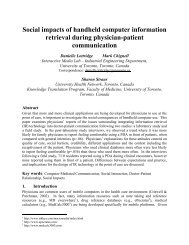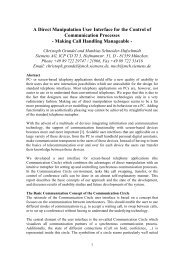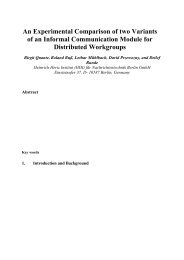Young Children and ICTs â current issues in the provision of ICT ...
Young Children and ICTs â current issues in the provision of ICT ...
Young Children and ICTs â current issues in the provision of ICT ...
You also want an ePaper? Increase the reach of your titles
YUMPU automatically turns print PDFs into web optimized ePapers that Google loves.
The use <strong>of</strong> <strong>ICT</strong> by children is seen as a ‘hot topic’ with<strong>in</strong> <strong>the</strong> <strong>in</strong>dustry. For example, a<br />
number <strong>of</strong> mobile operators with<strong>in</strong> <strong>the</strong> UK have set a Code <strong>of</strong> Practice for new forms <strong>of</strong><br />
content on mobile phones.[O2 et al (2003)] As part <strong>of</strong> this a classification framework will be<br />
established to classify content as not be<strong>in</strong>g suitable for under 18’s. This needs to be extended<br />
to differentiate content that is appropriate for children <strong>of</strong> different age groups.<br />
Access by young children to pornographic <strong>and</strong> o<strong>the</strong>r <strong>in</strong>appropriate content via <strong>the</strong> <strong>in</strong>ternet is<br />
<strong>of</strong> concern to many parents <strong>and</strong> guardians. Much effort, <strong>and</strong> some bl<strong>in</strong>d faith, has been<br />
<strong>in</strong>vested <strong>in</strong> block<strong>in</strong>g s<strong>of</strong>tware <strong>and</strong> content filters. However, <strong>the</strong>re rema<strong>in</strong> doubts about all<br />
filter<strong>in</strong>g technologies. Firstly, <strong>the</strong>y need ma<strong>in</strong>tenance <strong>and</strong> supervision by adults. Secondly,<br />
<strong>the</strong>y have flaws which sometimes cause un<strong>in</strong>tended block<strong>in</strong>g <strong>of</strong> allowed content. <strong>Young</strong><br />
children like a challenge, <strong>and</strong> break<strong>in</strong>g <strong>the</strong> security <strong>of</strong> <strong>the</strong> filter<strong>in</strong>g s<strong>of</strong>tware has become a sort<br />
<strong>of</strong> ‘underground’ game for many young people at vulnerable stages <strong>in</strong> <strong>the</strong>ir development. The<br />
serious issue <strong>of</strong> supplier implementation <strong>and</strong> adherence to voluntary rat<strong>in</strong>g schemes is ano<strong>the</strong>r<br />
difficulty. F<strong>in</strong>ally, as revealed by Which? [Which (Feb 2006)] recently, <strong>the</strong>re are security<br />
loopholes <strong>in</strong> all <strong>of</strong> <strong>the</strong>se types <strong>of</strong> systems, which can be exploited relatively easily. One such<br />
loophole <strong>in</strong>volved children who were gett<strong>in</strong>g access codes for pornographic material via text<br />
messages.<br />
9. Issues which need address<strong>in</strong>g<br />
This review shows that substantial progress has taken place <strong>in</strong> <strong>the</strong> area <strong>of</strong> young children <strong>and</strong><br />
<strong><strong>ICT</strong>s</strong>. However, much still rema<strong>in</strong>s to be done. The most urgent need is to address <strong>the</strong> <strong>issues</strong><br />
surround<strong>in</strong>g LBS. Codes <strong>of</strong> practice not withst<strong>and</strong><strong>in</strong>g, <strong>the</strong>re are emerg<strong>in</strong>g concerns on two<br />
levels. The first I have dealt with above, <strong>and</strong> is about whe<strong>the</strong>r or not LBS makes young<br />
children more safe or less safe. The second issue is <strong>the</strong> grow<strong>in</strong>g concern that parents are be<strong>in</strong>g<br />
misled about what LBS is, <strong>and</strong> what it can do. In <strong>the</strong> UK, for example, <strong>the</strong>re is a voluntary<br />
Code <strong>of</strong> Practice for LBS suppliers.[Work<strong>in</strong>g group <strong>of</strong> UK location service providers (2004)].<br />
There is some evidence that suppliers are not comply<strong>in</strong>g strictly with <strong>the</strong> terms <strong>of</strong> <strong>the</strong> Code.<br />
Ano<strong>the</strong>r major concern is about <strong>the</strong> rate <strong>of</strong> evolution <strong>of</strong> technologies, <strong>and</strong> <strong>of</strong> emerg<strong>in</strong>g<br />
products <strong>and</strong> services. It is difficult for parents, without considerable experience <strong>of</strong> <strong><strong>ICT</strong>s</strong>, to<br />
know where to draw <strong>the</strong> boundaries for <strong>the</strong> children’s use <strong>of</strong> today’s <strong><strong>ICT</strong>s</strong>. It is almost<br />
impossible for <strong>the</strong>m to underst<strong>and</strong> future products <strong>and</strong> services. Evaluation <strong>of</strong> <strong>the</strong> potential<br />
risks to young children <strong>of</strong> us<strong>in</strong>g new <strong>ICT</strong> products <strong>and</strong> services is a major research<br />
undertak<strong>in</strong>g. This effort will take time, <strong>and</strong> <strong>the</strong>refore guidel<strong>in</strong>es <strong>and</strong> o<strong>the</strong>r support for parents<br />
<strong>and</strong> young children necessarily lags beh<strong>in</strong>d large scale deployment. We need to f<strong>in</strong>d a way to<br />
deal with this, preferable through <strong>the</strong> use <strong>of</strong> technology neutral guidel<strong>in</strong>es – both for parents<br />
<strong>and</strong> young children, as well as for service providers. This would mean that parents could rely<br />
on <strong>the</strong> fact that suppliers will cont<strong>in</strong>ue to follow <strong>the</strong> ‘rules’, even when next generation <strong><strong>ICT</strong>s</strong><br />
are deployed.<br />
Draw<strong>in</strong>g up a set <strong>of</strong> rules about how service providers, <strong>and</strong> <strong>the</strong> <strong>in</strong>dustry <strong>in</strong> general, deals with<br />
customers who happen to be young children is ano<strong>the</strong>r priority. The avoidance <strong>of</strong> over<br />
regulation is not <strong>the</strong> only benefit to service providers from such an approach. On <strong>the</strong> positive<br />
side, self regulation is seen by parents <strong>and</strong> child agencies as a more effective approach to <strong>the</strong><br />
<strong>issues</strong> we have discussed <strong>in</strong> this paper.<br />
It is time to consider <strong>the</strong> benefits for service providers <strong>of</strong> a 'ChildFriendly' scheme. This<br />
would take <strong>the</strong> form <strong>of</strong> a code <strong>of</strong> practice, drawn up by <strong>the</strong> <strong>in</strong>dustry, <strong>and</strong> by each service








